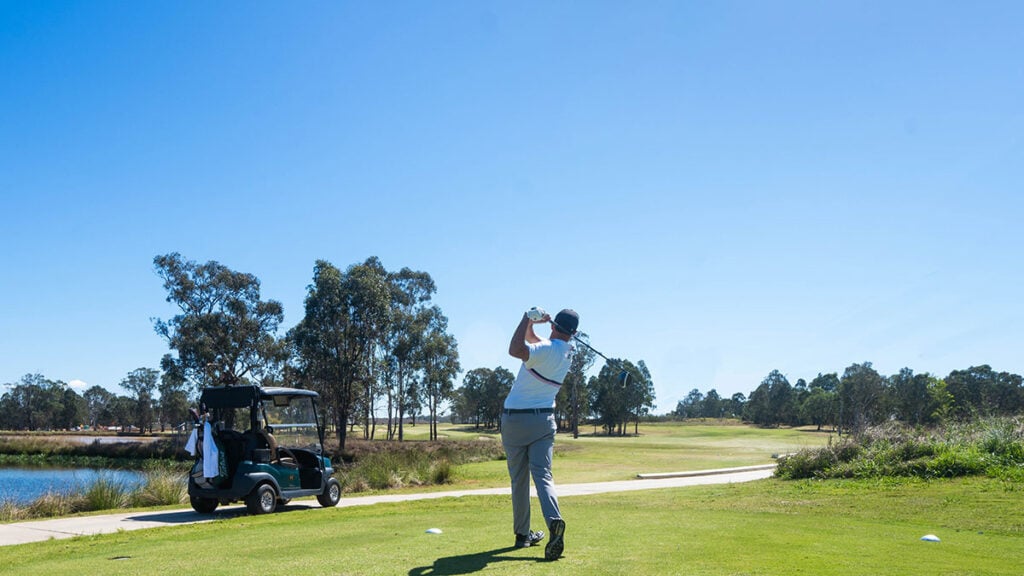WHEN the US media likes a Major champion, they go to town on propping him up. Usually it verges on annoying, but because Jason Day is one of our own, we kinda like it.
Here is the best over-the-top Jason Day articles following his US PGA Championship victory at Whistling Straits.
1. Golf Digest (US):
In case you need another reason to love Jason Day, here’s a story about the Aussie helping out a broke writer
If you don’t like Jason Day after this story, head to your nearest cardiologist to make sure you have a heart.
This comes from former Guardian golf correspondent Lawrence Donegan, speaking on the Off the Ball radio show in Ireland, regarding Day and a down-on-his-luck beat writer:
“One of the journalists is out on tour all the time and he’s not got a lot of money and he used to turn up every day with a shirt. So he’d have a red shirt for a Monday and a blue shirt for a Tuesday and Day eventually cottoned on to this and asked ‘How many shirts have you got?’ And he said, ‘Seven. One for every day of the week’ and Day said ‘meet me next week.’
“Day turned up the next week for 40 top quality golf shirts. He’s got a new sponsor and these were all the shirts from when he didn’t have a brand new sponsor and he gave them to the guy. I’d think that’s such a great story.”
So do we, Mr. Donegan. Learn more about Day in our piece on the PGA Championship winner.
2. Golf Digest (US):
How Jason Day’s caddie turned the golfer’s life around and led him to the Wanamaker Trophy
HAVEN, Wis. — Right beside Jason Day and his family as the golfer awaited the Wananaker Trophy was his caddie Col Swatton. Any distinction between immediate family can be dismissed when it comes to Day and his longtime mentor. When you talk about true impact on Day’s life, Swatton’s influence can’t be overstated.
Swatton has been there since Day was a teenager. When Day’s father died of cancer, Swatton was there. When Day needed guidance in his life as a mischievous teenager drinking at age 12, Swatton was there. For all the hours that Swatton has spent next to Day as he hit golf balls — thousands, easily, from his days as Day’s instructor at the Hills International Academy in Queensland, Australia, to the hundreds of PGA Tour events they’ve partnered up for — Swatton was right there.
And so he was Sunday at Whistling Straits.
That’s why the emotions streamed out of Day as he talked about Swatton after his major breakthrough at Whistling Straits. Their relationship goes beyond replacing divots and raking bunkers. It’s one of the most unique on the PGA Tour. Swatton’s presence in Day’s life was a big reason he ended up with the Wanamaker Trophy.
3. Golf.com – Meet 19-year-old Jason Day (re-posted from 2007):
Just after he turned pro in 2006, Jason Day, then 18, headed off to the TaylorMade testing center, in Carlsbad, Calif., to be fitted for a new set of clubs. He grabbed a 5-iron and started taking cuts.
“You’re swinging pretty easy,” one technician said. “Can you swing any faster?”
“Sure,” Day said. He loaded onto his right side and — whoosh! — knifed the club through the air. The readout: 105 mph, just shy of the PGA Tour average — with a driver. The boys in the lab had never seen such velocity. Who was this kid?
The most heralded rookie on Tour in 2008 is a self-assured, 20-year-old Australian who might one day surpass Greg Norman, Geoff Ogilvy and Adam Scott. He’s won more in his teens than that trio, and now he’s talking about out-winning even the game’s sacred swoosh, Woods. And he won’t be laying up much in the process. (“If there’s a gap in a tree, I go for it,” says Day.)
The kid’s got the game to back up the bravado. In 2006, playing seven Tour events on sponsors’ exemptions, Day made five cuts, including two top-15s. He failed Q School later that year, but last July, at 19, Day became the youngest winner of a Tour-sanctioned event (take that, Tiger!), shooting four rounds in the 60s to win the Nationwide’s Legend Financial Group Classic in Cleveland. In his next four starts, he finished T5, 2 (shooting a Nationwide-record-tying weekend score of 62-63), T13 and 3, assuring his call-up to the Show.
Wherever it happens, the time is near. It could arrive this month or next, or this spring or summer, but someday soon on a pimped-out golf course in a prime zip code, this boy who would be king will stand shoulder-to-shoulder with the reigning sovereign. Not bad for a kid who grew up in near-poverty, whose first club came from a trash heap.
In the clubhouse this past fall at the Albertsons Boise Open, a Nationwide Tour event, Day is polishing off lunch. Other pros amble by and razz him for indulging yet another writer. He laughs, loving it. They’ve adopted him as a Major League team adopts its bat boy, provided that the bat boy is a young Barry Bonds. They know he’ll surpass them soon, but today Day is all doe-eyed innocence, a slender, tan kid with white teeth and black clothing from TaylorMade and Adidas. “Oh, man,” Day says, exhilarated at the prospect of the dream matchup with Tiger. “Everyone is working toward something. I’m trying to work toward taking that No. 1 spot from him.” Day looks so young that it’s surprising to learn that he shaves. He wants to get big. Not just in stature but in sinew, with the muscled back and tapered waist. “Athletically ripped,” he says. He and his idol are the same height: 6’1″. Each moves the ball more than 300 yards off the tee, although the stats say Day is a few paces longer. They’re telegenic and multiethnic, Day the product of a Filipino mother and an Australian father. But Woods is physically broader, and that’s no trivial matter. When you want to be a pioneer, to be the first to put the mighty Woods on his heels, these are the things you think about. You play a limited number of tournaments, 15 to 20, as Tiger does, because burnout is real. You sign a deal with Adidas because, well, Nike’s got its man. And you contemplate the size of your biceps.
How do you approach the subject of taking down a man who’s never fallen? Bud Martin of SFX Sports, Day’s agent, hates the angle that Day is going to suddenly blow away big, bad Tiger. But Martin does little to dispel the idea when he says of the kid, “He could end up being the best ever.” Day was 14 and playing a practice round with Greg Norman and Adam Scott at the Australian PGA when he first caught the attention of Martin, who quickly judged the kid the most talented of the three. Ian Davis, Day’s manager in Australia, played with Norman in the 1970s and rates Day “a shot better a round than Norman was at a comparable age.” Adds Colin Swatton, Day’s caddie and coach: “He’s just an all-around package. A lot of people say he’s got the maturity of a 30-year-old in the body of a [20-year-old].”
What sets Day apart isn’t just his swing speed but his short game, a strength that distinguishes You Know Who. “I played with Jason when he was 16 in the Aussie Open,” says Jarrod Lyle, a 26-year-old touring pro who lives a few minutes from Day in the Bay Hill neighborhood of Orlando. “Some of the shots he played around the green were just unbelievable. I walked off that course thinking he’s got one of the greatest short games I’ve ever seen.”
At the Nationwide Tour’s Jacob’s Creek Open in Adelaide, Australia, last February — his first tournament of his first full year as a pro — Day was on the Friday cut line as he came to the par-5 18th. The pin was tucked on a high ledge in the right corner of the green, but Day shoved his 3-iron approach 30 yards right, onto a patch of hardpan. The caddie was thinking: Pitch it up there 30 feet behind the hole, two-putt — and hope. Instead, Day opened the face of his 58-degree wedge, picked the ball perfectly off the rock-hard earth, dropped it onto a three-foot-wide landing and watched it stop five feet from the cup. He made the putt and the cut, on the number.
In Day’s first five PGA Tour starts in 2006, he made 190 of 212 putts from 10 feet or less. That stat would have put him among the leaders on Tour had he played enough rounds to make it official, not to mention the fact that he was fourth in driving distance (310 yards), 10th in driving accuracy (72.4 percent) and second in greens in regulation (72.2 percent). Such feats are not the result of talent alone, those close to Day will tell you. He dug his game out of the Australian dirt. He works hard. He wants it. As a teenager at boarding school, Day taped above his bunk bed a goals list, to which he vowed total dedication. He’d set his alarm for 5 a.m., so he could be practicing by 5:30. He had weak legs, so Swatton gave him a pivot drill to keep the kid from moving off the ball, a drill Day was doing three months later, long after the coach had forgotten about it.
It’s not hard tracing one source of his dedication. “I was very poor when I was young,” says Day, the son of Queensland meat workers, explaining away the three PlayStations and the $60,000 Cadillac Escalade he keeps at his Orlando home. He bought school clothes one year at St. Vincent de Paul — everything he could cram in a bag for $5. “Just looking when I was little at pictures of cars and houses that I wanted — it gives you a certain motivation, it gives you a goal.” Day first hit balls at age 6, using a 3-wood that his father, Alvin, found on a trash heap, but he was preoccupied with other sports. That changed when his dad died of stomach cancer. Day, 12, his two older sisters and their mother, Dening, were devastated. Jason started to drink. He got into fights. Dening sent the boy to a golf academy that doubled as a boarding school. Day eventually connected with his new mentor, Swatton, the golf coach. They’ve been inseparable ever since, the coach serving as a surrogate father.
Day broke 70 for the first time at age 12. By 15 — in 2003 — he’d read a biography of Woods and, while impressed, resolved to outdo even Tiger. Among Day’s goals for ’08 is to win twice, just as Woods did in 1996. (He learned from Tiger in more ways than one. Before winning the Junior World at Torrey Pines, Day studied the course, virtually, via video game: EA Sports’ Tiger Woods Golf.) At 16, Day captured the Queensland Amateur, becoming the youngest champion in the event’s 104-year history. He also made a major swing change to create more leverage and add distance. But will Day’s confident comments rile the World No. 1? Woods is legendary for using perceived slights as motivation. Just ask Michael Campbell, Stephen Ames, and Rory Sabbatini. Yet Day seems different, the first player who can back up the talk long-term. In so many ways, he’s the same as Woods: The short game, the poise. And, so far, the results.
While Day admits that a player could be intimidated by Tiger’s physique, the boyish wonder withholds judgment on the rest, including the supposedly jaw-dropping ball flight and percussive sound of Tiger’s compressed Nike. “I don’t know, we’ll have to wait and see how Tiger hits it,” Day says. “If he hits it good, it’ll be intimidating, I reckon. He’s done it for more years, and he’s smarter, he’s mature, he’s bigger. But I’m a lot like him. I can play a number of different shots in my bag.”
Is that enough to rile Woods? Maybe it doesn’t matter. No one remembers what Buster Douglas said leading up to the fight. They just remember Mike Tyson on his back. Day will get at least one mulligan, because even Woods botched his first chance to win as a pro, losing to frumpy Ed Fiori at the 1996 Quad City Classic. But after that… “It sounds big, but I want to win,” Day says, hopeful that an inflamed right wrist that sidelined him for the last two Nationwide events of 2007 won’t interfere. “I want to get out of the blocks pretty quick and win an event.” Or two. It’s on the goals list. Because that’s the model. That’s what Tiger did at 20.
Day was driving through California last October for a Nationwide event, and he couldn’t help but dream: He imagined the handshake, the eye contact, the electricity of the moment. The likely where and when of his first meeting with Woods: Torrey Pines, site of the Buick Invitational, January 24-27, as well as the U.S. Open host in June. What if he faces down Woods in Torrey’s final stretch, at either event? Swatton was in the car, and he asked his charge if he was ready for such a showdown.
Day’s response: “Bring it on.”




